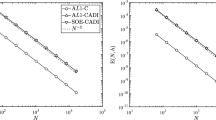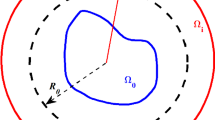Abstract
In this paper, we develop an operator splitting Fourier spectral method for models of epitaxial thin film growth with and without slope selection. A main idea of the method is to split the original equation into linear and nonlinear parts, and then to evolve one step which consists of three substeps. The linear part is solved by the spectral method, which has a closed-form solution in the Fourier space. And the nonlinear part is also solved by the spectral method combined with the Crank–Nicolson type method. We numerically demonstrate that our method achieves spectral accuracy in space and second-order accuracy in time and alleviates restriction on the time step. We also perform long time simulations for the coarsening process to show the capability of the method.



















Similar content being viewed by others
References
Ehrlich, G., Hudda, F.G.: Atomic view of surface self-diffusion: Tungsten on tungsten. J. Chem. Phys. 44, 1039–1049 (1966)
Schwoebel, R.L., Shipsey, E.J.: Step motion on crystal surfaces. J. Appl. Phys. 37, 3682–3686 (1966)
Schwoebel, R.L.: Step motion on crystal surfaces. II. J. Appl. Phys. 40, 614–618 (1969)
Ortiz, M., Repetto, E.A., Si, H.: A continuum model of kinetic roughening and coarsening in thin films. J. Mech. Phys. Solids 47, 697–730 (1999)
Johnson, M.D., Orme, C., Hunt, A.W., Graff, D., Sudijono, J., Sander, L.M., Orr, B.G.: Stable and unstable growth in molecular beam epitaxy. Phys. Rev. Lett. 72, 116–119 (1994)
King, B.B., Stein, O., Winkler, M.: A fourth-order parabolic equation modeling epitaxial thin film growth. J. Math. Anal. Appl. 286, 459–490 (2003)
Li, B., Liu, J.-G.: Thin film epitaxy with or without slope selection. Eur. J. Appl. Math. 14, 713–743 (2003)
Moldovan, D., Golubović, L.: Interfacial coarsening dynamics in epitaxial growth with slope selection. Phys. Rev. E 61, 6190–6214 (2000)
Golubović, L.: Interfacial coarsening in epitaxial growth models without slope selection. Phys. Rev. Lett. 78, 90–93 (1997)
Wang, C., Wang, X., Wise, S.M.: Unconditionally stable schemes for equations of thin film epitaxy. DCDS-A 28, 405–423 (2010)
Eyre, D.: Unconditionally gradient stable time marching the Cahn–Hilliard equation. MRS Proc. 529, 39–46 (1998)
Shen, J., Wang, C., Wang, X., Wise, S.M.: Second-order convex splitting schemes for gradient flows with Ehrlich–Schwoebel type energy: application to thin film epitaxy. SIAM J. Numer. Anal. 50, 105–125 (2012)
Chen, W., Wang, C., Wang, X., Wise, S.M.: A linear iteration algorithm for a second-order energy stable scheme for a thin film model without slope selection. J. Sci. Comput. 59, 574–601 (2014)
Chen, W., Conde, S., Wang, C., Wang, X., Wise, S.M.: A linear energy stable scheme for a thin film model without slope selection. J. Sci. Comput. 52, 546–562 (2012)
Strang, G.: On the construction and comparison of difference schemes. SIAM J. Numer. Anal. 5, 506–517 (1968)
Chertock, A., Doering, C.R., Kashdan, E., Kurganov, A.: A fast explicit operator splitting method for passive scalar advection. J. Sci. Comput. 45, 200–214 (2010)
Lee, H.G., Lee, J.-Y.: A semi-analytical Fourier spectral method for the Allen–Cahn equation. Comput. Math. Appl. 68, 174–184 (2014)
Lee, H.G., Lee, J.-Y.: A second order operator splitting method for Allen–Cahn type equations with nonlinear source terms. Phys. A 432, 24–34 (2015)
Lee, H.G., Shin, J., Lee, J.-Y.: First and second order operator splitting methods for the phase field crystal equation. J. Comput. Phys. 299, 82–91 (2015)
Kao, C.-Y., Kurganov, A., Qu, Z., Wang, Y.: A fast explicit operator splitting method for modified Buckley–Leverett equations. J. Sci. Comput. 64, 837–857 (2015)
Jahnke, T., Lubich, C.: Error bounds for exponential operator splittings. BIT Numer. Math. 40, 735–744 (2000)
Lubich, C.: On splitting methods for Schrödinger–Poisson and cubic nonlinear Schrödinger equations. Math. Comput. 77, 2141–2153 (2008)
Chertock, A., Kurganov, A., Petrova, G.: Fast explicit operator splitting method for convection-diffusion equations. Int. J. Numer. Methods Fluids 59, 309–332 (2009)
Holden, H., Karlsen, K.H., Risebro, N.H., Tao, T.: Operator splitting for the KdV equation. Math. Comput. 80, 821–846 (2011)
Holden, H., Lubich, C., Risebro, N.H.: Operator splitting for partial differential equations with Burgers nonlinearity. Math. Comput. 82, 173–185 (2013)
Cheng, Y., Kurganova, A., Qu, Z., Tang, T.: Fast and stable explicit operator splitting methods for phase-field models. J. Comput. Phys. 303, 45–65 (2015)
Medovikov, A.A.: High order explicit methods for parabolic equations. BIT Numer. Math. 38, 372–390 (1998)
Li, B., Liu, J.-G.: Epitaxial growth without slope selection: energetics, coarsening, and dynamic scaling. J. Nonlinear Sci. 14, 429–451 (2004)
Xu, C., Tang, T.: Stability analysis of large time-stepping methods for epitaxial growth models. SIAM J. Numer. Anal. 44, 1759–1779 (2006)
Author information
Authors and Affiliations
Corresponding author
Additional information
This research was supported by the RP-Grant 2016 of Ewha Womans University and the Basic Science Research Program through the National Research Foundation of Korea (NRF) funded by the Korea government MOE (2009-0093827) and MSIP (2015-003037).
Rights and permissions
About this article
Cite this article
Lee, H.G., Shin, J. & Lee, JY. A Second-Order Operator Splitting Fourier Spectral Method for Models of Epitaxial Thin Film Growth. J Sci Comput 71, 1303–1318 (2017). https://doi.org/10.1007/s10915-016-0340-4
Received:
Revised:
Accepted:
Published:
Issue Date:
DOI: https://doi.org/10.1007/s10915-016-0340-4




